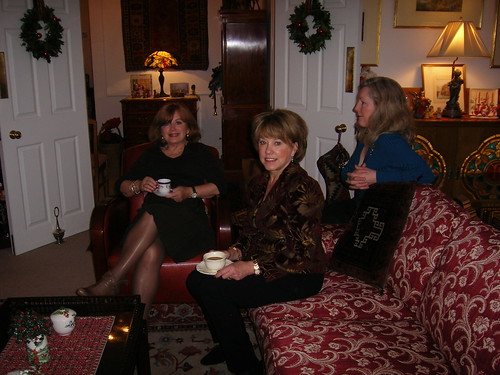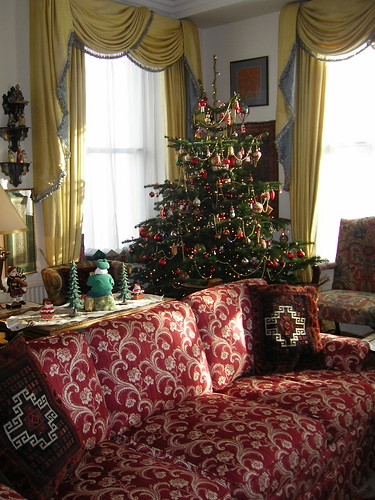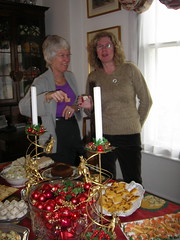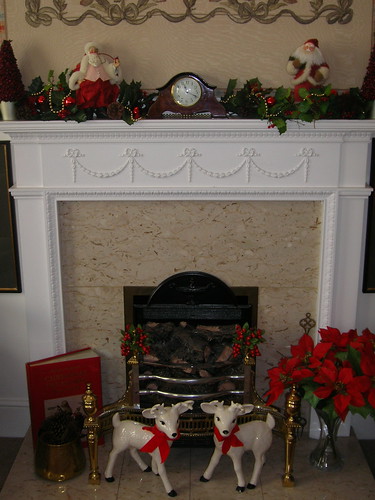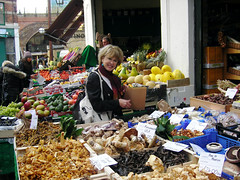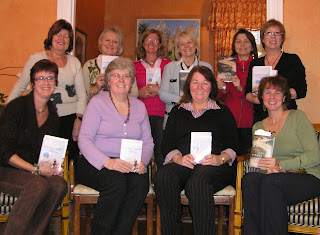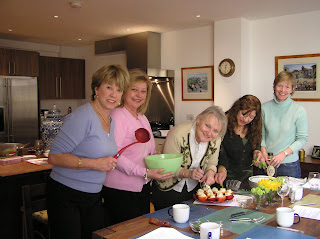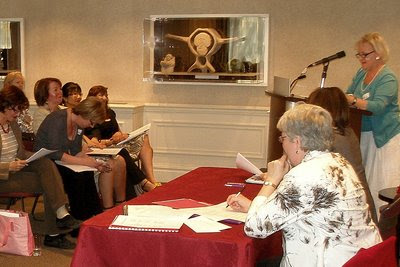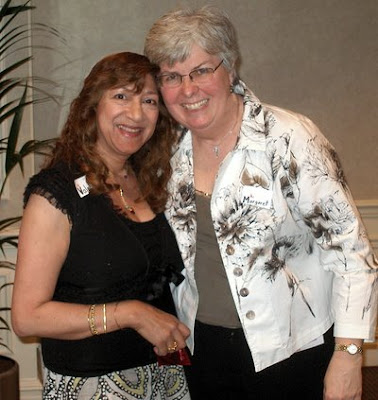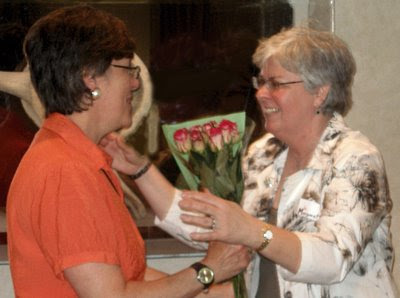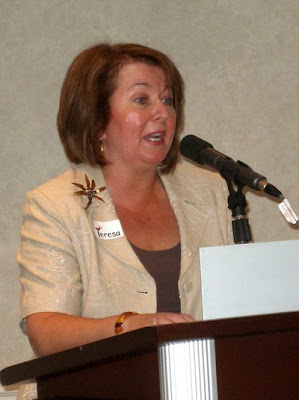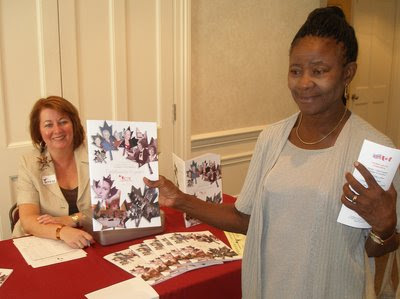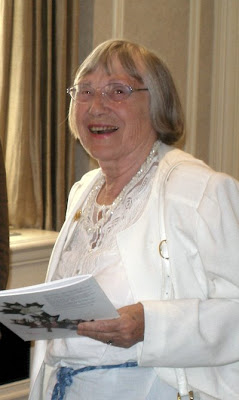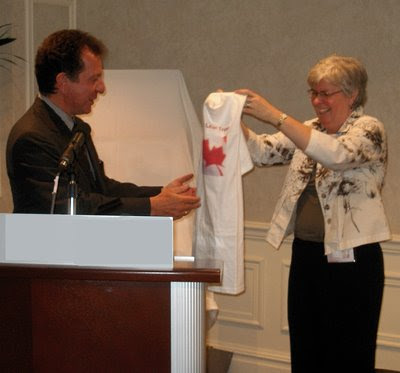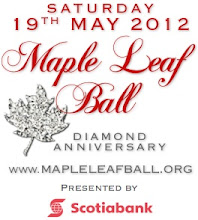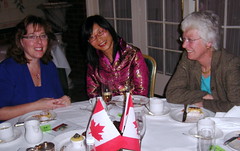
On the 20th of November, 30 CWC members enjoyed a wonderful afternoon of conversation and fun - topped off with a delicious afternoon tea of delicate sandwiches, scones with cream, and gorgeous cakes at the beautiful Chesterfield Mayfair Hotel in London. Vice-President Patty Bell made the afternoon very special for all of us, with table decorations and raffle prizes. Along with Canadian flags on the table, we were all presented with a special copy of Teresa Howe's article, 'For the Love of Tea', which looks at this British tradition and is reproduced below the photos for the enjoyment of members who weren't able to attend on the day.
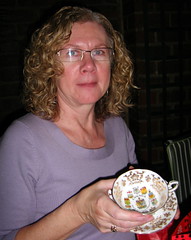

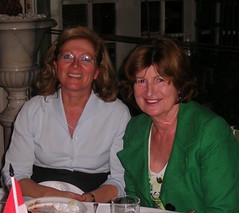
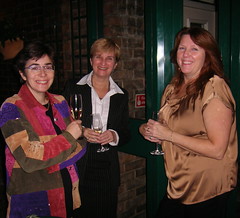
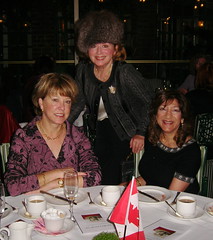 For the Love of Tea
For the Love of Tea, by Teresa Howe
"Thank God for tea! What would the world do without tea? How did it exist? I am glad that I was not born before tea." – William Gladstone, British Prime Minister
From the poshest of hotels to the cosiest of country pubs, in the largest high street shops and the tiniest of bakeries, from the top of Hadrian’s Wall to the tip of Eastbourne, one can indulge in every conceivable version of tea. And from the simplicity of a home-baked scone smothered in clotted cream to a lavish Dorchester Hotel Champagne Tea, there are venues and costs for every taste.
Tea is both a drink and an event. There are Strawberry Teas for charities, miniature afternoon tea by fashion designer Nicole Farhi, and chocolate teas to be sweetly savoured at the Baglioni Hotel or the Flemings Hotel. A meaty Men’s Tea is on offer at the Mandeville Hotel or low-fat Afternoon De-Light at the Metropolitan. This year there was Sex in the City Tea at the Berkeley, complete with Blahnik-inspired shoe cookies and Cosmopolitans. For dancers, there are Tango Teas at the Waldorf Hilton. Sizzling cabaret acts at Volupté, London’s premier burlesque lounge, turns afternoon tea into afternoon tease. During the Chelsea Flower Show, Harvey Nichols offers edible flower cakes and blossom-scented champagnes.
 Tea Trade
Tea Trade Catherine of Braganza, daughter of King John IV of Portugal and wife of Charles II, introduced tea to the English court in 1662. Her dowry included the Portuguese trading posts of Tangier and Bombay, a fortune in gold and a chest of tea. In 1658, the China Drink, a green tea shipped by the East India Company, was sold at the “Sultaness Head, a cophee-house” near London Bridge. Over time this exotic import began to appear in stores such as the Twining family trade and Buttons of Covent Garden. It was the first comestible that Fortnum & Mason sold when it opened for business in 1707.
Tea provided the basis for a widening of trade with the East through the 18th and 19th centuries, with imports from British plantations in Assam, Darjeeling, Nilgiri and, later, Ceylon. The consumption of Black tea with the European addition of sugar and milk, grew steadily. Chests of tea were stacked high in Butler’s Wharf, Hay’s Wharf, Wapping and near today’s Millennium footbridge.
The Industrial Revolution’s Tea WorkersTea was becoming the lifeblood of Britain. Household servants were provided with tea allowance and many employers provided free tea to employees. English author Tom Standage even asserts that tea was crucial to the Industrial Revolution as it was a beverage well suited to an industrialized factory setting. Unlike beer, which was given to agricultural workers, tea (and its caffeine) did not dull the mind but sharpened it. Tea kept workers alert on long and tedious shifts, fending off their hunger and fortifying their concentration. The natural antibacterial properties of tea were also an advantage since they reduced waterborne diseases such as dysentery. The improvement in the nation’s health was attributed to tea during the 19th century.
In the mid 1800s, the first public tea rooms opened in Scotland, then London, where everyone could meet for a “cheap pot of tea, sweet and savoury foods and a bit of gossip”. Tea rooms and gardens were designed for predominantly women clientele as places they could attend without chaperones.
The British Empire and TeaThe rise of tea and the growth of Britain were intertwined. Fashion, commerce and social changes all played their part in the phenomenal embrace of tea. It was consumed by every class in Britain and in almost every home, making it the most widely consumed beverage on earth after water. Deeply entrenched in British culture, it was featured in many of Charles Dickens’ classics, including Great Expectations and Oliver Twist.
As the British Empire expanded, British administrators drank tea wherever they travelled in the world. British soldiers on the battlefields of Europe and the Crimea also brought tea with them. It was ultimately this love affair with tea that changed world history. The Tea Act of 1773, tea taxes, and finally the famous Boston Tea Party, in which protesters emptied three shiploads of tea into Boston harbour, proved a decisive step towards Britain’s loss of its American colonies.
Afternoon Tea versus High TeaAfternoon tea was introduced in 1841 by Anna Maria, wife of the seventh Duke of Bedford, as she felt peckish during the long gap between lunch (eaten at 1.00 pm) and dinner (eaten at or after 7.00 pm). She decided to entertain her friends at Woburn by offering tea and small bites around 4.00 pm. By the 1860s, the fashion for elegant afternoon tea was widespread.
While upper classes would serve a low or afternoon tea around 4:00 or 5:00 pm to tide them over between lunch and dinner, high tea was common amongst the working class. At the end of a long day, they would sit down to one meal of strong tea and hearty hot food. The names derive from the height of the tables on which the meals are served. High tea would be served at the high or main (or only) table, while the upper classes would serve afternoon tea or low tea on small lounge tables.
Is it Milk in First or Tea in First? The debate continues. In 1946 George Orwell wrote an essay called “A Nice Cup of Tea” in the Evening Standard newspaper, calling tea “one of the mainstays of civilization in this country” and listing his 11 golden rules for proper tea-making. British tea parties had the formality of Chinese and Japanese tea ceremonies. The hostess would pour the tea and men (or daughters if no men present) were responsible for passing cups. Tea gowns and gloves were the norm.
Tea in Troubling TimesIn the early 20th century, hotels were regularly designed to include a colonial palm court or a stylish tea lounge where guests could take tea and enjoy the genteel sounds of an orchestra or string quartet. In 1912, the tango arrived from Buenos Aires and tea dances became the latest intoxication. But those days were short-lived. Tea sales suffered as men went off to fight in WWI and the National Tea Control was introduced in 1918. Historian A.A. Thompson declared that tea was England’s secret weapon and is what “keeps us going and is what will carry us through” troubled times.
During and after WWII, food was in short supply and tea was rationed from 1940 to 1952. The economy was in a slump and few could afford elegant tea rooms. In the mid 1950s, new life emerged and the American influence was strong, including coffee. It was not until the 1980s that tea houses reappeared. The British enthusiasm for tea was back.
My Cup OverflowsFor me, the ultimate tea experience is The Royal Garden Party held at the three Royal Palaces each summer. A tradition dating back to the 1860s, this is an opportunity to meet members of the Royal family, dress in finery and experience one of the most exclusive events in Britain. A typical party serves approximately 27,000 cups of tea, 20,000 sandwiches and 20,000 slices of cake and an average 8,000 guests per party! But if you have not been lucky enough to receive an invitation from Lord Chamberlain on behalf of Her Majesty, then treat your friends royally to a tea party at home. Many expat groups, including The Commonwealth Countries League, FIWAL and the Canadian Women’s Club of London, enjoy tea parties at the home of one of their members who happen to have 90 champagne glasses, 90 sets of tea china and a lovely garden. Waitrose, M&S and caterers can prepare feasts of scones, jams, perfect little sandwiches and gorgeous sweets.
With the help of the Tea Council, the tea guild, Britons and tourists, the pleasures of enjoying afternoon tea are once again popular. Perhaps it’s time to put the kettle on and contemplate what a different world it would be without tea.
This is a shortened version of an article and its sources which will appear in FOCUS Magazine’s January 2009 edition.

